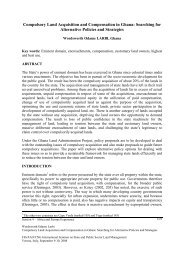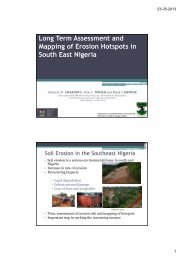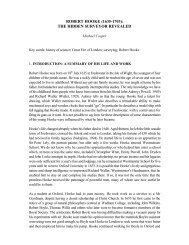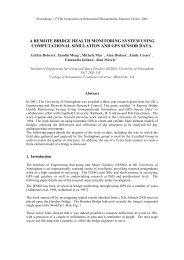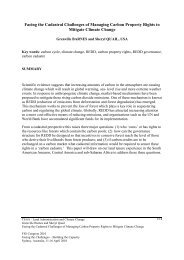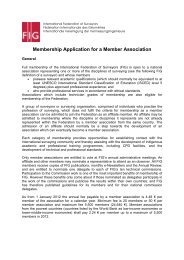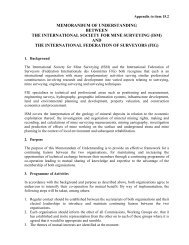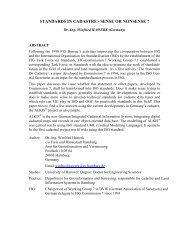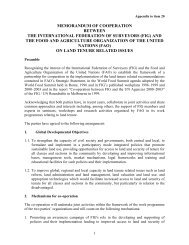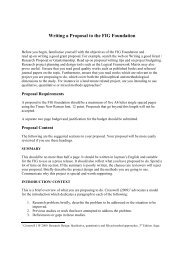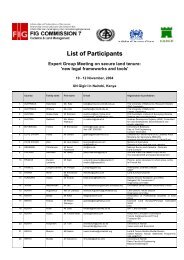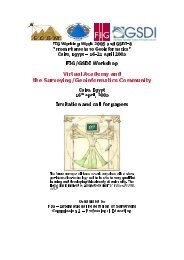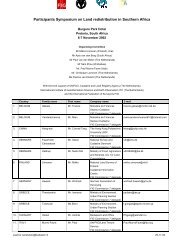Plane Based Free Stationing for Building Models - FIG
Plane Based Free Stationing for Building Models - FIG
Plane Based Free Stationing for Building Models - FIG
You also want an ePaper? Increase the reach of your titles
YUMPU automatically turns print PDFs into web optimized ePapers that Google loves.
With respect to the given space index structure the planes will be linked together in order to<br />
receive stochastic in<strong>for</strong>mation. Finally a plane set with stochastic descriptions as features of a<br />
point cloud has been derived as shown in Figure 5. To estimate the trans<strong>for</strong>mation parameters<br />
homologous planes have to be found in a matching process.<br />
4. PLANE BASED MATCHING<br />
In order to add 3D in<strong>for</strong>mation from a point cloud to a building model trans<strong>for</strong>mation<br />
parameters are needed. To determine these parameters homologous planes have to be used<br />
instead of points. The disadvantage of homologous points is its visibility during the lifetime of<br />
the building. It is easier to find points at the same plane then just discrete points. The biggest<br />
advantage by using planes <strong>for</strong> matching purposes is that planes can be detected automatically<br />
with its stochastic in<strong>for</strong>mation.<br />
4.1 Functional Model<br />
To find trans<strong>for</strong>mation parameters from a given plane a functional relationship between plane<br />
parameters and the searched trans<strong>for</strong>mation parameters have to be determined. Figure 6<br />
displays two planes where plane 1 is a model plane whereas plane 2 is a plane from a point<br />
cloud. Both planes corresponding to each other thus they describe the same face in real world.<br />
Both planes can be described with the Hessian Normal <strong>for</strong>m (1) and (2).<br />
0���� ��� �� ��� �1� 0���� ��� �� ��� �2�<br />
The equations above are true if the points �� � are located on a plane.<br />
The foot point of plane1 can be described as shown in equation (3) by the normal ��� � and the<br />
distance parameter ��. �� � ���� ��� �3�<br />
If the foot point will be trans<strong>for</strong>med by applying the searched trans<strong>for</strong>mation parameters<br />
between both planes it fulfills the hessian normal equation of the second plane (2).<br />
TS09E - Engineering Surveying - Software, 5118<br />
Christian Manthe<br />
<strong>Plane</strong> <strong>Based</strong> <strong>Free</strong> <strong>Stationing</strong> <strong>for</strong> <strong>Building</strong> <strong>Models</strong><br />
<strong>FIG</strong> Working Week 2011<br />
Bridging the Gap between Cultures<br />
Marrakech, Morocco, 18-22 May 2011<br />
�� �� ���� ����_�� ��� �4�<br />
Equation (4) shows the point trans<strong>for</strong>mation between two systems where � is the rotation<br />
matrix and �� is the vector <strong>for</strong> the translations. By substituting (4) in equation (2) and the use<br />
of the foot point equation (3) we get finally (5).<br />
0���� � ���� ������ ��� � � � �<br />
0���� ���� ����_�� ���� ��� ��� 0 � ��� ����� ��� ���� ��� ��� �5�<br />
6/10



